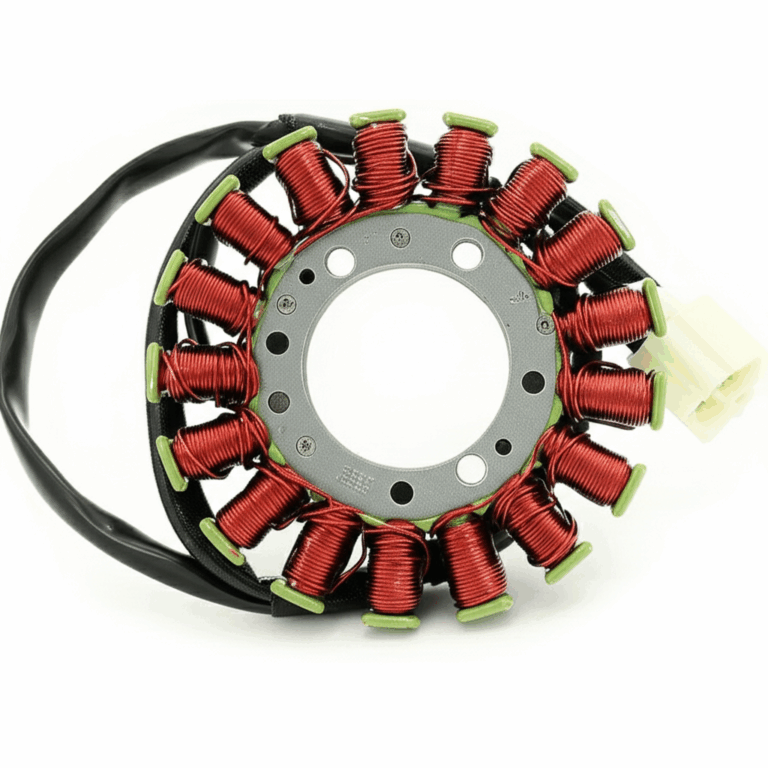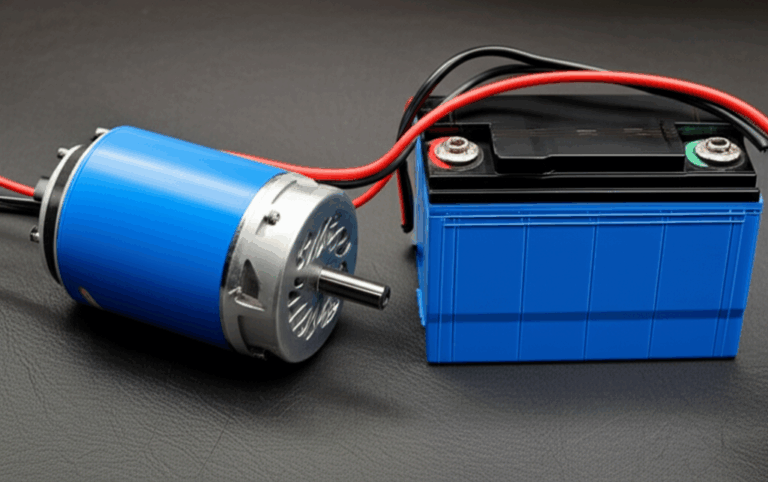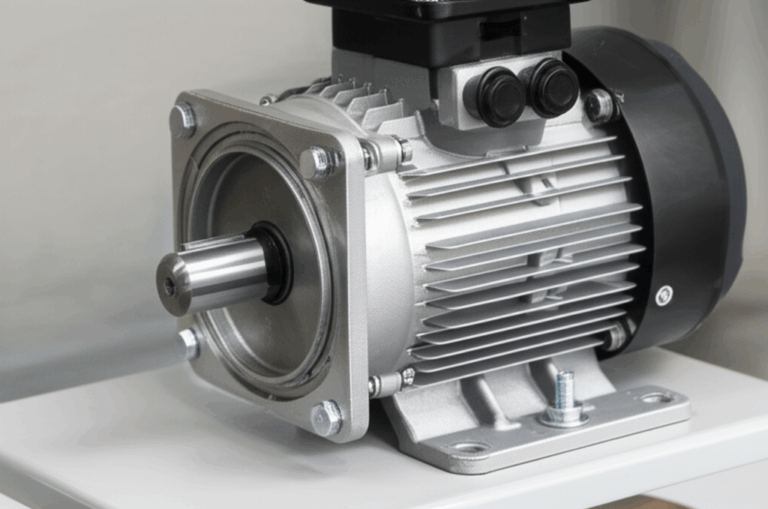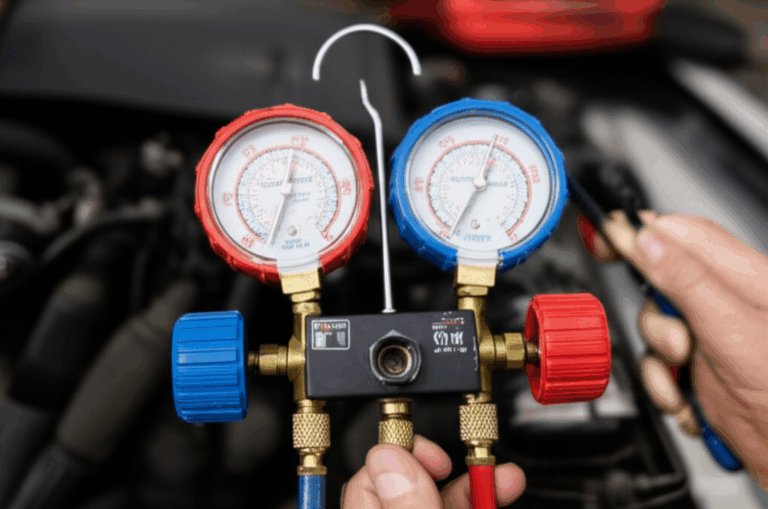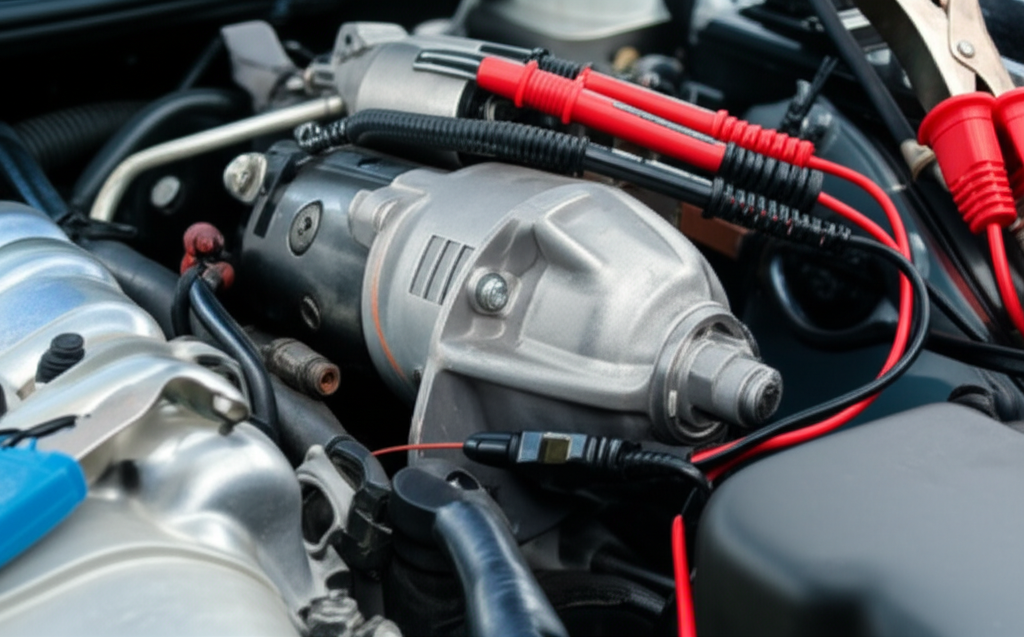
How to Test a Starter Motor: A Step-by-Step DIY Guide (On-Car & Off-Car)
Short summary: I show you how to test a starter motor on the car and off the car. You learn the tools, the steps, and what your results mean. Read this if your car clicks, cranks slow, or won’t crank at all. You save time and money. You make smart choices. You fix the real problem.
Table of Contents
- What problem are you facing right now?
- What does a starter motor do?
- What are the signs of a bad starter?
- What tools do you need to test a starter?
- How do you stay safe while you test?
- How do you test the starter on the car?
- How do you run a voltage drop test the right way?
- How do you bypass the relay with care?
- How do you bench test a starter off the car?
- What do your test results mean?
- What should you do next?
- How much will this cost you?
- Brand and engine notes you should know
- Glossary of simple terms you will see in this guide
- Quick data, facts, and why this matters
- FAQ
- Key takeaways
What problem are you facing right now?
Problem: Your car will not start. You hear a clicking sound from the engine bay. Or the engine won’t turn over. Maybe it cranks slow. You are not sure if it is the battery or the starter motor. You need a starter motor diagnostic that you can trust.
Agitate: Guessing costs money. Many drivers replace a starter that is fine. The real issue hides in a cable or a relay. I have done it myself. It hurts your budget. It steals your time. It also leaves you stuck in a no crank condition when you need to go.
Solution: I walk you through a clear on-car and off-car car starter test. You learn how to check a starter with a multimeter starter test, a voltage drop test starter, and a starter motor bench test. You will see how to identify a bad starter, how to test the starter solenoid, and how to use simple tools. I keep it safe and simple.
What does a starter motor do?
Your starter motor cranks the engine. It takes power from the battery. The solenoid acts like a heavy switch and pushes the pinion gear into the flywheel ring gear on the crankshaft. The Bendix drive and overrunning clutch let the pinion spin the engine then freewheel.
Inside the starter you may find an armature, field coils or permanent magnets, carbon brushes, and a commutator. Some cars use a gear reduction starter. Some use a series wound starter. Some small engines use a permanent magnet starter. The housing holds it all. Bearings support the shaft. The starter mount bolts it to the engine or transaxle.
What are the signs of a bad starter?
Look for bad starter symptoms. You may hear a clicking sound starter. You may only hear a single click. You may get grinding noise starter. The starter spins but won’t engage the engine. Or the engine cranks slowly or not at all.
Some issues come and go. You may have intermittent starter issues. You may see smoke. You may ask why is my starter making noise. You may ask why won’t my car start after rain. Water can get in a connector. A weak battery can mimic a starter problem. We will sort that out.
What tools do you need to test a starter?
You do not need fancy gear. Here is a simple list.
- Multimeter with voltage and ohms. If it reads amperage that helps with starter motor current draw.
- Wrenches. A socket set and an open-end wrench set.
- Jumper cables. You need these for a bench test.
- Battery load tester. This is optional but nice.
- Test light. Fast checks get easier.
- Wire brush and a battery terminal cleaner.
- Floor jack and jack stands if you work under the car.
- Safety glasses and gloves.
You may also use a battery charger to top off the battery. If you work near the starter mount use a torque wrench to hit starter motor torque specs. Keep the positive and negative cable neat. Keep the ground wire clean. Good tools make automotive electrical diagnostics easy.
Here is a handy tools table you can print.
| Tool | What it does | Notes |
|---|---|---|
| Multimeter | Voltage, ohms test starter | Look for 12.6V on a full battery |
| Load tester | Battery load test | Shows cranking amps test result |
| Test light | Fast power checks | Good for the solenoid S-terminal |
| Jumper cables | Bench test power | Use thick cables |
| Wrenches | Remove and tighten | Follow torque specs |
| Wire brush | Clean connections | Stops voltage drop |
How do you stay safe while you test?
- Park on level ground. Set the parking brake. Put the car in Park or Neutral. A manual transmission must sit in Neutral.
- Wear safety glasses and gloves. You protect your eyes and hands.
- Disconnect the battery before removal. Remove the negative terminal first. Reconnect it last. This avoids sparks.
- Use jack stands if you lift the car. Never work under a car that sits on a floor jack.
- Keep loose clothes away from moving parts. Work in a well-ventilated area.
I cannot say this enough. You work with high current. A short can burn parts fast. Stay alert.
How do you test the starter on the car?
Step 1: Basic battery and cable check.
- Check battery voltage. It should be about 12.6V at rest. If it reads 12.2V or less the battery is low.
- Clean battery terminals and starter cables. Use a wire brush. Tighten loose clamps.
- Run a battery load test if you can. A weak battery test vs starter test can fool you. Fix the battery first.
Step 2: Test the starter solenoid.
- Find the starter motor and solenoid. The small wire on the solenoid is the S-terminal.
- Have a helper turn the key to START. Check for 12V at the S-terminal with a multimeter or test light.
- If no power then check the ignition switch test, the neutral safety switch test, the starter relay, fuses for starter motor, and wiring. Check the anti-theft system or immobilizer if your car has one. The Engine Control Unit (ECU) and Battery Management System (BMS) may also block crank.
Step 3: Check grounds and power feeds.
- Trace the positive cable starter from the battery to the starter. Look for damage. Check the starter relay location in the fuse box.
- Check the negative cable starter and the ground wire to the engine block near the starter. Clean both ends. Good grounds stop many no-start cases.
If the engine still will not crank you move to voltage drop testing.
How do you run a voltage drop test the right way?
A voltage drop test starter finds hidden resistance. You test under load. You test while the key sits in START and the starter tries to crank.
- Positive side drop: Place one lead on battery positive. Place the other lead on the starter positive terminal. Have a helper crank. Read the meter. A drop near or above 0.5V is too high. Clean connections. Retest.
- Negative side drop: Place one lead on battery negative. Place the other on the engine block near the starter. Crank. A drop near or above 0.5V is too high. Clean and tighten the ground path.
High voltage drop means bad connections or a bad cable. Fix that first. This test prevents unnecessary starter motor replacement.
Here is a quick guide.
| Path | Good drop | Action if high |
|---|---|---|
| Positive cable | Under 0.5V | Clean or replace cable |
| Negative/ground | Under 0.5V | Clean ground wire and block lug |
How do you bypass the relay with care?
This is an advanced step. Use it only if you feel sure. You can hot wire a starter to see if it spins.
- Use a remote starter switch or a jumper wire with an inline fuse.
- Jump power from the battery positive to the solenoid S-terminal. The starter should crank if the motor and solenoid work.
- Bypass the starter relay only for a quick check. Do not crank for long. You can get hurt if the car is in gear. You can damage parts if you slip.
If you do not like this step do not do it. You can bench test the starter instead.
How do you bench test a starter off the car?
Step 1: Remove the starter motor safely.
- Disconnect the battery. Negative off first.
- Unbolt the starter. Support it with one hand. Remove the wiring. Note wire positions. Some cars have heat shields. Some have tight spaces near the transaxle. A repair manual helps with your specific vehicle identification number (VIN) and car manufacturer steps.
Step 2: Bench test setup.
- Clamp the starter motor in a vise. Wear safety glasses and gloves.
- Connect the negative jumper cable from a fully charged battery to the starter motor casing. This is your ground.
- Connect the positive jumper cable to the main power terminal on the starter.
- Use a small jumper to touch the solenoid S-terminal to the positive battery post. Do this briefly.
Step 3: What should you see?
- Good starter: The solenoid clicks. The pinion gear extends with force. The motor spins strong and smooth.
- Bad solenoid: It clicks but the pinion does not move. Or the motor does not spin.
- Bad motor: The pinion extends but the motor does not spin. Or it spins weakly. Or it makes grinding noises.
- No response: Check your connections first. If they are good the solenoid or motor is dead.
What do your test results mean?
If your on-car tests show no power at the S-terminal then the issue sits in the ignition switch, neutral safety switch, starter relay, fuses, or wiring. The anti-theft or immobilizer can block the ECU from sending a start signal.
If your voltage drop test shows a big drop then clean or replace the battery cables and grounds. A battery cable check often solves the problem. Many “starter problems” go away when you clean and tighten starter bolts and terminals.
If your bench test shows a weak spin or harsh grinding then the brushes, armature, field coil test, or bearings may be worn. The Bendix drive test may fail. You may need a starter motor repair or a starter motor rebuild kit. You can also replace the unit.
What should you do next?
If your starter tests good:
- Look at the battery and charging system. Run a battery load test. Do an alternator output test.
- Check the ignition system check. Look for a bad relay or fuse. Test the neutral safety switch. Inspect the starter motor circuit.
- If it cranks but still will not start then check fuel and engine basics. Run an engine compression test. Do a fuel delivery test.
If your starter tests bad:
- Choose a new, OEM, or remanufactured starter. Compare remanufactured starter vs new. OEM vs aftermarket starter both can work. Check the starter motor warranty.
- If you want to rebuild then check carbon brush replacement starter, commutator wear, armature coil test, field coil test, and the overrunning clutch. Follow torque specs on install and use the heat shield if your car came with one.
How much will this cost you?
Let’s talk money.
- Cost to diagnose starter at a shop: about $80 to $180.
- Starter motor replacement cost: parts and labor often run $300 to $800 or more. Heavy duty starter and luxury models can cost more.
- DIY starter test time: 30 to 90 minutes.
- DIY replacement time: 1 to 4 hours. It depends on the vehicle and how easy the starter sits to reach.
- You can save $200 to $600 if you do both the test and the replacement yourself.
Preventive tips save you cash. Clean connections. Use a battery charger when needed. Do preventative maintenance starter checks twice a year.
Brand and engine notes you should know
Different brands place the starter in different spots. The wiring also varies. Here are quick notes.
- Ford starter test and Chevy starter test often sit low on the engine. Watch for heat shield and ground straps.
- Honda starter test and Toyota starter test sit near the transaxle. Space can be tight.
- VW starter test, BMW starter test, and Mercedes starter test may link to the ECU and immobilizer. Scan for codes if you have a no crank condition with no S-terminal power.
- Diesel starter motor test needs a strong battery. Diesel engines have high compression.
- Small engine starter test, marine starter test, ATV starter test, motorcycle starter test, and heavy duty starter test follow the same basics. Check battery, cables, solenoid, and motor.
Always check a wiring diagram for your car manufacturer. Follow the fuse box map. Look up the starter relay location. Use your VIN to match parts.
Glossary of simple terms you will see in this guide
I kept this list short and clear. Use it as a quick helper while you test.
- Starter motor troubleshooting: Steps to find what is wrong with your starter.
- Automotive starter testing: All tests you do on and off the car.
- Car starter test: A check to see if the starter works.
- How to check starter: The simple path I showed you.
- Starter solenoid test: Check if the solenoid gets power and moves.
- Clicking sound starter: Often a low battery or bad connection.
- No crank condition: The engine does not turn at all.
- Battery test vs starter test: Find out if the battery is weak or the starter is bad.
- Multimeter starter test: Use a meter to check voltage and resistance.
- Starter motor bench test: Test the starter off the car with jumper cables.
- Starter motor removal: Take the starter off the car.
- How to jump start a car: Use cables to crank with help from another car.
- Starter motor wiring diagram: A map of wires in the starter circuit.
- Continuity test starter: Check if a wire or coil is not broken.
- Voltage drop test starter: Find high resistance in cables and grounds.
- Starter motor replacement cost: The money you pay to swap the unit.
- Relays and starter motor: The relay sends power to the solenoid.
- Ignition switch test: Check if the switch sends a start signal.
- Neutral safety switch test: Makes sure the car is in Park or Neutral before it cranks.
- Flywheel inspection: Look for broken or worn teeth on the ring gear.
- Bendix drive test: See if the pinion moves out and engages.
- Pinion gear starter: The small gear that turns the ring gear.
- Armature coil test: Check for shorts or opens in the armature.
- Field coil test: Check the field coils in non-permanent magnet starters.
- Carbon brush replacement starter: Swap worn brushes to get good contact.
- Battery cable check: Look for corrosion or loose clamps.
- Ground wire starter: The return path for current.
- Positive cable starter: The feed from the battery to the starter.
- Negative cable starter: The ground cable from battery to chassis or engine.
- Starter motor circuit: All wires, relays, fuses, and the starter.
- Starter motor current draw: How much current the starter uses while cranking.
- Ohms test starter: Check resistance of windings and cables.
- How to identify a bad starter: Use the tests above and the symptoms.
- Engine won’t turn over: Same as no crank.
- Starter spins but won’t engage: Pinion does not hit the ring gear.
- Grinding noise starter: Worn pinion or ring gear or bad alignment.
- Starter clicking but no start: Often a weak battery or bad cable.
- What causes starter failure: Wear, heat, dirt, bad brushes, weak solenoid, or bad connections.
- Starter motor life expectancy: Many last 5 to 10 years or 100,000 to 150,000 miles.
- DIY starter test: You do the tests at home.
- Professional starter test: A trained mechanic does it with pro tools.
- Starter motor repair: Fix parts inside the starter.
- Remanufactured starter vs new: A rebuilt unit vs a brand-new unit.
- Tools for starter test: The list we gave above.
- Safety precautions starter test: The safety steps above.
- Disconnecting battery for starter: Always do it before removal.
- Testing starter without removing: On-car tests.
- Testing starter in car: Same as on-car tests.
- Testing starter off car: Bench test.
- How to hot wire a starter: Jump power to the S-terminal to crank.
- Bypass starter relay: Jump the circuit for testing only.
- Ford starter test, Chevy starter test, Honda starter test, Toyota starter test, VW starter test, BMW starter test, Mercedes starter test: Brand-specific checks.
- Diesel starter motor test, Small engine starter test, Marine starter test, ATV starter test, Motorcycle starter test, Heavy duty starter test: Tests for different machines.
- Permanent magnet starter, Series wound starter, Gear reduction starter: Types of starter motors.
- Starter motor brush wear: Brushes wear down over time.
- Solenoid plunger test: Make sure the plunger moves smoothly.
- Starter overrunning clutch: Lets the pinion freewheel after start.
- Starter motor heat shield: Shields the starter from exhaust heat.
- Symptoms of a weak starter: Slow crank and dim lights while cranking.
- Intermittent starter issues: Works sometimes then fails.
- Starter motor current consumption: Same as current draw.
- Starter motor specifications: Torque, current, and fit details.
- Cranking amps test: Battery test under load.
- Battery load test: Checks battery health.
- Alternator output test: Checks charging system after start.
- Why is my starter making noise: Often gear or alignment issues.
- How to clean starter connections: Brush and tighten all lugs.
- Tightening starter bolts: Stops movement and grinding.
- Starter motor inspection: Look for wear and damage.
- Starter relay location: Find it in the fuse box or power center.
- Fuses for starter motor: Check for blown fuses.
- Ignition system check: Make sure the car can spark and run when it cranks.
- Engine compression test and Fuel delivery test: If it cranks but does not start.
- Starter motor rebuild kit: Parts to repair a starter.
- Starter motor torque specs: Use a torque wrench on install.
- Preventative maintenance starter: Clean and check parts ahead of time.
- How often do starters fail: It varies by use and heat.
- Cost to diagnose starter: The fee a shop charges.
- Starter motor warranty: Ask before you buy.
- OEM vs aftermarket starter: Factory brand vs other brands.
- Why won’t my car start after rain: Moisture in cables or connectors.
- Clicking sound from engine bay: Often low battery or corroded terminals.
- Starter motor power consumption: Same as current draw.
Key entities you will run into while testing:
- Starter Motor, Battery, Solenoid, Ignition Switch, Relay, Neutral Safety Switch
- Transaxle, Crankshaft, Flywheel, Ring Gear, Pinion Gear, Bendix Drive
- Armature, Field Coils, Carbon Brushes, Commutator, Permanent Magnets
- Housing, Bearings, Starter Cables, Ground Wire
- Multimeter, Jumper Cables, Battery Charger, Battery Load Tester, Test Light
- Wrenches, Wire Brush, Safety Glasses, Gloves, Jack Stands, Floor Jack
- Battery Terminal Cleaner, Engine Control Unit (ECU), Fuse Box, Battery Management System (BMS), Anti-Theft System, Immobilizer
- Manual Transmission, Automatic Transmission
- Vehicle Identification Number (VIN), Car Manufacturer, Automotive Mechanic
- Electrical Circuit, Voltage Drop, Current Draw, Ohms, Cranking Amps
- Engine Bay, Starter Mount
Quick data, facts, and why this matters
Here are real-world insights from roadside reports, shop experience, and training best practices. They help you avoid bad guesses.
| Data point | What it means | Approx numbers | Basis |
|---|---|---|---|
| Misdiagnosis rate | Many “bad starters” are not bad | 20–30% | Industry observations and tool makers |
| Battery vs starter | Most no-starts come from the battery or cables | 60–70% battery issues, 15–25% starter issues | Service data and AAA roadside trends |
| Starter lifespan | How long a starter lasts | 5–10 years or 100k–150k miles | Manuals and mechanic experience |
| Common failures | What fails inside | Solenoid 30–40%, Brushes 25–35%, Armature/Field 15–20%, Gears 10–15% | Shop tear-downs |
| Voltage drop | Why it matters | Over 0.5V drop points to bad cables or grounds | Electrical best practices |
| Bench test | How solid it is | About 95–99% accurate for the part itself | Component testing standards |
| Clean connections | Cheap fix pays off | Up to 25% solved by cleaning and tightening | Roadside assistance data |
Where quality parts matter for long life
If you build or rebuild electric motors you know the core matters. The heart of a strong starter motor sits in the steel laminations inside the stator and rotor. High grade laminations cut core loss. They reduce heat. They help the motor spin with less current. That means longer brush life and fewer hot spots around the commutator.
If you source components for motors or generators then look at proven suppliers. You can learn more about precision electrical steel laminations. For complete stacks see motor core laminations. You can also review rotor core lamination and stator core lamination. Better cores help motors run cooler and smoother. That pays off in starters, BLDC drives, and more.
FAQ
Q: How long does a starter motor last?
A: Many last 5 to 10 years or 100,000 to 150,000 miles. Heat, short trips, and start-stop systems can shorten life.
Q: Can a bad battery mimic a bad starter?
A: Yes. A weak battery or corroded terminals can cause clicking, slow crank, or no crank. Test the battery first.
Q: What is the difference between a starter and a solenoid?
A: The starter motor spins the engine. The solenoid pulls the pinion gear into the ring gear and closes the high current circuit.
Q: Is it safe to tap a starter with a hammer?
A: It can free stuck brushes for a short time. It is not a fix. Use light taps only. Replace or repair the unit soon.
Q: What are the signs of a failing starter relay?
A: No power at the S-terminal with the key in START. You may hear no click at the starter. Check the relay, fuse, and control circuit.
Key takeaways
- Test the battery and cables before you blame the starter.
- Use a multimeter for a voltage drop test under load.
- Check for 12V at the solenoid S-terminal when you turn the key.
- Bench test the starter off the car for a clear yes or no.
- Clean, tight connections fix many no-start issues.
- Choose quality parts if you replace or rebuild.
- Stay safe. Disconnect the battery before removal.
- Keep notes. It makes the next job faster.
References:
- AAA Roadside Assistance annual battery reports and starting system trends.
- Bosch Automotive Handbook, electrical fundamentals and starter systems.
- Manufacturer service manuals for brand-specific torque specs and wiring diagrams.
- ASE and automotive electrical training materials on voltage drop testing and diagnostics.

